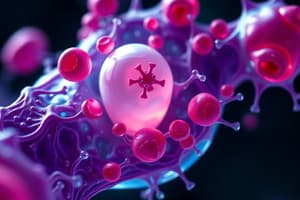Podcast
Questions and Answers
What is the main difference between prokaryotic and eukaryotic cells?
What is the main difference between prokaryotic and eukaryotic cells?
Prokaryotic cells lack a nucleus and membrane-bound organelles, whereas eukaryotic cells have a nucleus and membrane-bound organelles.
What are the seven life processes that all living organisms exhibit?
What are the seven life processes that all living organisms exhibit?
Movement, Reproduction, Sensitivity to Stimuli, Growth, Respiration, Excretion, and Nutrition.
What is the function of the nuclear membrane?
What is the function of the nuclear membrane?
It surrounds the nucleus, has openings that allow material to enter and leave the nucleus, and is made of two layers.
What is the difference between the RER and SER?
What is the difference between the RER and SER?
What is the structure of the mitochondria?
What is the structure of the mitochondria?
What is the difference between active and passive transport?
What is the difference between active and passive transport?
What is the definition of diffusion?
What is the definition of diffusion?
What was Rosalind Franklin's contribution to the discovery of DNA structure?
What was Rosalind Franklin's contribution to the discovery of DNA structure?
What is the function of the cell membrane?
What is the function of the cell membrane?
What is the function of the nucleolus?
What is the function of the nucleolus?
Flashcards are hidden until you start studying
Study Notes
Cell Types
- Prokaryotic cells: no nucleus, no membrane-bound organelles (e.g. Bacteria)
- Eukaryotic cells: has nucleus, has membrane-bound organelles (e.g. Plants, Animals)
Organisms
- Unicellular organisms: single cell (e.g. Amoeba)
- Multicellular organisms: multiple cells (e.g. Humans, Plants)
Multiorganism Groups
- Viruses
- Bacteria
- Fungi
- Algae
Seven Life Processes
- Movement (M)
- Reproduction (R)
- Sensitive to Stimuli (S)
- Growth (G)
- Respiration (R)
- Excretion (E)
- Nutrition (N)
Organelles and Their Functions
Cell Membrane
- Outer membrane of the cell
- Double layer
- Keeps cell contents together
- Controls diffusion and active transport of substances in and out of the cell (semi-permeable/selectively permeable)
Nuclear Membrane
- Surrounds the Nucleus
- Made of two layers
- Openings allow material to enter and leave the Nucleus
Nucleus and Nucleolus
- Controls all metabolic activities of the cell
- Makes proteins
- Makes ATP
- Contains all genetic material (DNA for inheritance)
- Replicates DNA (makes copies, mitosis)
- Nucleolus contains RNA to build proteins
Endoplasmic Reticulum
- RER makes proteins
- SER makes fats and lipids
- Transports lipids and proteins in transport vesicles to the Golgi Body
Mitochondria
- Site of majority of ATP synthesis (cellular respiration)
- Muscle cells have the most mitochondria due to high energy requirements
- Double membrane-bound organelles
- Inner membrane arranged into cristae to increase surface area and maximize ATP production
- Has own DNA, inherited from maternal line
Structures of Organelles
Cell Membrane
- Phospholipid bi-layer
- Hydrophilic heads (phosphate)
- Hydrophobic tails (lipids)
- Transports proteins
- Fluid mosaic model
Nucleus
- Surrounded by Nuclear Envelope (membrane)
- Contains Nucleoplasm
- Nucleolus (RNA)
- Chromatin Network (DNA)
- Nuclear Envelope surrounded by Endoplasmic Reticulum
Mitochondria
- Inner membrane arranged into cristae
- Matrix contains enzymes for cellular respiration
Endoplasmic Reticulum
- System of interconnected membranes
- ER is the largest organelle in the cell
- Internal transport of the cell
- RER has ribosomes attached for protein synthesis
- Smooth ER synthesizes and stores lipids
Transportation within the Cell
- Active Transport: against a concentration gradient, needs energy (ATP)
- Passive Transport: along a concentration gradient, no energy needed
Tonicity
- Hypertonic: solution contains more dissolved particles (e.g. salt) than water
- Hypotonic: solution contains less dissolved particles (e.g. salt) than water
- Isotonic: solution has the same salt concentration and water concentration
Definitions
- Diffusion: movement of molecules from high concentration to low concentration
- Osmosis: movement of water molecules from high concentration to low concentration through a cell's semi-permeable membrane, against/along the concentration gradient
- Concentration Gradient: difference in concentration of a dissolved substance in a solution or gas between two regions
DNA and Coding
History of DNA Discovery
- Friedrich Miescher discovered DNA
- Rosalind Franklin discovered DNA density and helical conformation
- James Watson and Francis Crick determined DNA double-helix structure in 1953
DNA Structure
- DNA has a double-helix structure
- Contains genetic material
Studying That Suits You
Use AI to generate personalized quizzes and flashcards to suit your learning preferences.




